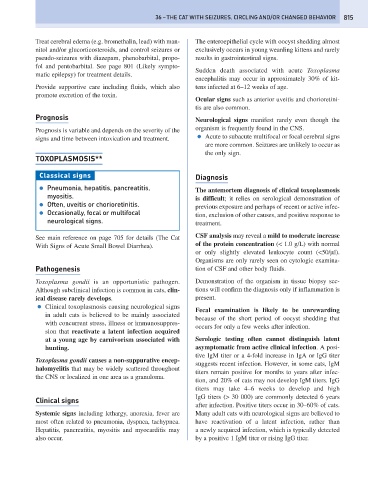Page 823 - Problem-Based Feline Medicine
P. 823
36 – THE CAT WITH SEIZURES, CIRCLING AND/OR CHANGED BEHAVIOR 815
Treat cerebral edema (e.g. bromethalin, lead) with man- The enteroepithelial cycle with oocyst shedding almost
nitol and/or glucorticosteroids, and control seizures or exclusively occurs in young weanling kittens and rarely
pseudo-seizures with diazepam, phenobarbital, propo- results in gastrointestinal signs.
fol and pentobarbital. See page 801 (Likely sympto-
Sudden death associated with acute Toxoplasma
matic epilepsy) for treatment details.
encephalitis may occur in approximately 30% of kit-
Provide supportive care including fluids, which also tens infected at 6–12 weeks of age.
promote excretion of the toxin.
Ocular signs such as anterior uveitis and chorioretini-
tis are also common.
Prognosis Neurological signs manifest rarely even though the
Prognosis is variable and depends on the severity of the organism is frequently found in the CNS.
signs and time between intoxication and treatment. ● Acute to subacute multifocal or focal cerebral signs
are more common. Seizures are unlikely to occur as
the only sign.
TOXOPLASMOSIS**
Classical signs Diagnosis
● Pneumonia, hepatitis, pancreatitis, The antemortem diagnosis of clinical toxoplasmosis
myositis. is difficult; it relies on serological demonstration of
● Often, uveitis or chorioretinitis. previous exposure and perhaps of recent or active infec-
● Occasionally, focal or multifocal tion, exclusion of other causes, and positive response to
neurological signs. treatment.
See main reference on page 705 for details (The Cat CSF analysis may reveal a mild to moderate increase
With Signs of Acute Small Bowel Diarrhea). of the protein concentration (< 1.0 g/L) with normal
or only slightly elevated leukocyte count (<50/μl).
Organisms are only rarely seen on cytologic examina-
Pathogenesis tion of CSF and other body fluids.
Toxoplasma gondii is an opportunistic pathogen. Demonstration of the organism in tissue biopsy sec-
Although subclinical infection is common in cats, clin- tions will confirm the diagnosis only if inflammation is
ical disease rarely develops. present.
● Clinical toxoplasmosis causing neurological signs
Fecal examination is likely to be unrewarding
in adult cats is believed to be mainly associated
because of the short period of oocyst shedding that
with concurrent stress, illness or immunosuppres-
occurs for only a few weeks after infection.
sion that reactivate a latent infection acquired
at a young age by carnivorism associated with Serologic testing often cannot distinguish latent
hunting. asymptomatic from active clinical infection. A posi-
tive IgM titer or a 4-fold increase in IgA or IgG titer
Toxoplasma gondii causes a non-suppurative encep-
suggests recent infection. However, in some cats, IgM
halomyelitis that may be widely scattered throughout
titers remain positive for months to years after infec-
the CNS or localized in one area as a granuloma.
tion, and 20% of cats may not develop IgM titers. IgG
titers may take 4–6 weeks to develop and high
IgG titers (> 30 000) are commonly detected 6 years
Clinical signs
after infection. Positive titers occur in 30–60% of cats.
Systemic signs including lethargy, anorexia, fever are Many adult cats with neurological signs are believed to
most often related to pneumonia, dyspnea, tachypnea. have reactivation of a latent infection, rather than
Hepatitis, pancreatitis, myositis and myocarditis may a newly acquired infection, which is typically detected
also occur. by a positive 1 IgM titer or rising IgG titer.

